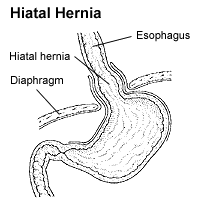
Photo from wikipedia
IntroductionPublished data regarding robot-assisted hiatal hernia repair are mainly limited to small cohorts. This study aimed to provide information on the morbidity and mortality of robot-assisted complex hiatal hernia repair… Click to show full abstract
IntroductionPublished data regarding robot-assisted hiatal hernia repair are mainly limited to small cohorts. This study aimed to provide information on the morbidity and mortality of robot-assisted complex hiatal hernia repair and redo anti-reflux surgery in a high-volume center.Materials and methodsAll patients that underwent robot-assisted hiatal hernia repair, redo hiatal hernia repair, and anti-reflux surgery between 2011 and 2017 at the Meander Medical Centre, Amersfoort, the Netherlands were evaluated. Primary endpoints were 30-day morbidity and mortality. Major complications were defined as Clavien–Dindo ≥ IIIb.ResultsPrimary surgery 211 primary surgeries were performed by two surgeons. The median age was 67 (IQR 58–73) years. 84.4% of patients had a type III or IV hernia (10.9% Type I; 1.4% Type II; 45.5% Type III; 38.9% Type IV, 1.4% no herniation). In 3.3% of procedures, conversion was required. 17.1% of patients experienced complications. The incidence of major complications was 5.2%. Ten patients (4.7%) were readmitted within 30 days. Symptomatic early recurrence occurred in two patients (0.9%). The 30-day mortality was 0.9%. Redo surgery 151 redo procedures were performed by two surgeons. The median age was 60 (IQR 51–68) years. In 2.0%, the procedure was converted. The overall incidence of complications was 10.6%, while the incidence of major complications was 2.6%. Three patients (2.0%) were readmitted within 30 days. One patient (0.7%) experienced symptomatic early recurrence. No patients died in the 30-day postoperative period.ConclusionsThis study provides valuable information on robot-assisted laparoscopic repair of primary or recurrent hiatal hernia and anti-reflux surgery for both patient and surgeon. Serious morbidity of 5.2% in primary surgery and 2.6% in redo surgery, in this large series with a high surgeon caseload, has to be outweighed by the gain in quality of life or relief of serious medical implications of hiatal hernia when counseling for surgical intervention.
Journal Title: Surgical Endoscopy
Year Published: 2018
Link to full text (if available)
Share on Social Media: Sign Up to like & get
recommendations!